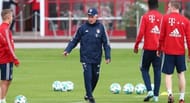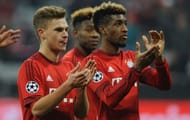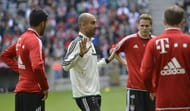
"I can assure you that I am not going to coach again. I had a worthy farewell," said Jupp Heyneckes back in June 2013.
And quite a worthy farewell it was indeed. Heyneckes had won the Bundesliga title four times as a player with Borussia Monchengladbach and a further three times with Bayern from the touchline – spanning a career that featured 1011 Bundesliga games as player and coach. A record-breaking season on the way to a historic trouble felt like the perfect parting gift.
Yet when the team struggled early on in the 2017-18 campaign, they turned to their beloved former manager. A tepid start to the Bundesliga season had frayed nerves, and a 3-0 mauling at PSG was the final straw. Ancelotti oozes charisma and a sense of calm – but Bayern Munich had become too calm for their own good, and were lulled in an early season stupor.
5 months later, Bayern hold an unassailable 19 point lead at the top of Bundesliga. They have stormed into the DFB Pokal semifinals. Besiktas has been tossed aside in the first leg of CL Round of 16. What exactly has changed?
How has Jupp Heyneckes lifted Bayern Munich out of their early season stupor?
#1 Reinstating Javi Martinez to midfield
Javi Martinez’s partnership with Bastian Schweinsteiger in central midfield was instrumental in Bayern’s successful 2012-13 season. Imposing his physicality on games, Martinez harried the opposition’s creative midfielders and drove his team forward to great effect.
Under Guardiola and Ancelotti, Martinez was pushed back into central defence, both due to tactical reasons and lack of personnel. After Heyneckes’ return, he has reinstated Martinez to his preferred holding midfield position and has shored up their midfield dominance in the process.
#2 Greater physical fitness and higher pressing

A reported lack of intensity in training under Ancelotti had deprived Bayern of the physical edge they enjoyed in games under Guardiola. Arturo Vidal exemplified this lack of fitness, with the former Juventus midfielder looking a shadow of his former energetic box-to-box self. With the return of Heyneckes, the demand in training has been restored. Vidal has risen above his dip in form to get back on track again.
Bayern seem capable of running their opponents into submission again, rather than simply relying on greater talent to help them win matches. Heyneckes has also brought back his brand of counter-pressing. Players like Robben seem eager to fight for the ball again after losing it. In modern football, talent can only get you so far – even the likes of Real, Barca and Bayern need to put in a shift to ensure sustained success.
#3 Youth players revival

Young players like Kimmich and Coman have found their feet again
Ancelotti’s penchant for the tried and tested meant players like Kingsley Coman were often overlooked. Time will tell if Renato Sanches’ current dip is simply temporary – if so, the young man was another whose career stuttered under Ancelotti. Even Joshua Kimmich, hailed Germany’s next superstar, complained about his lack of game time back in March.
Not just youth players, even the likes of Thomas Muller and James Rodriguez failed to produce their best under Ancelotti. Muller, in particular, has finally found his role again as a floating player in a 4-2-3-1, whereas he looked lost in Ancelotti’s rigid 4-3-3. James Rodriguez, too, has played the best football of his Bayern career from the No.10 position.
With the reintegration of youth players, Heyneckes has raised Bayern’s energy levels; with a lineup that ideally balances youth with experience.
#4 Tactical nous

Heyneckes has leveraged the tactical intelligence Bayern players developed under Guardiola
Bayern players were exposed to cutting-edge position play and tactical ideas under Guardiola. Though they complained about the intensity, they had grown to love it – so much so, in fact, that the players took it upon themselves to include a high tempo rondo (a piggy-in-the-middle one-touch game) in their prematch training even after Guardiola’s departure.
Ancelotti’s rigid 4-3-3 in the face of both success and failure was destined to be short-lived. It relied excessively on the individual brilliance of Thiago Alcantara and Robert Lewandowski – and was unable to find answers when the individuals had an off-day or were stymied.
Heyneckes, during his time out, seems to have widened his horizon for more schemes and shapes. Bayern have lined up in 4-3-3, 4-2-3-1 and 4-1-4-1 systems; and the wide array of tactical options available from the personnel have been effectively put to use.
#5 Regained the dressing room

As a beloved former manager, Heyneckes has regained control of the dressing room and restored focus
That’s what it all comes down to, isn’t it? The players. Unlike in our Sega-inspired Football Manager utopias, Sunderland can’t win the league even with Mourinho or Guardiola in charge – conversely, Bayern Munich won’t fall out of Champions League positions even with Neil Warnock in charge.
Once he lost the dressing room, Ancelotti had lost the plot irrespective of his ability to engineer a revival. “There were five Bayern players against Ancelotti,” said Bayern president Uli Hoeness. “It was impossible to get out of that.”
Heyneckes’ return brought back fond memories, and the players responded immediately. The hunger seen in his first game back in charge, a 5-0 win against Freiburg, was a stark contrast to the lacklustre team that turned up in Paris.
Bayern Munich have become a team to fear again - now it remains to be seen whether Heyneckes can match the dizzying heights the team reached in 2013.
